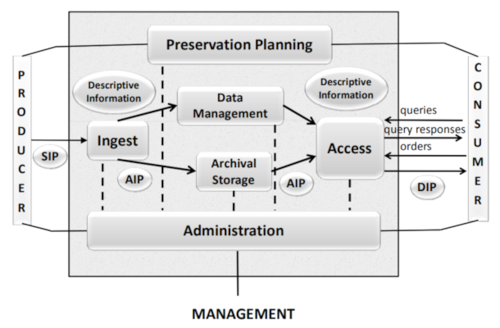The OAIS Reference Model
The Open Archival Information System (OAIS) Reference Model is designed to provide a comprehensive framework to help organizations maintain and preserve access to digital information over the long term. It is widely used by archives, libraries, and other institutions responsible for preserving digital content.
In summary, the OAIS Reference Model is a guiding framework for organizations seeking to develop systems for the long-term preservation of digital information. It addresses key aspects of digital archiving, from the initial acquisition of data to its long-term preservation and access, ensuring that digital information remains usable and understandable well into the future.

Key concepts of the OAIS model
Key players
- Producer: The role played by those persons or client systems that provide the information to be preserved.
- Archive: An organization that intends to preserve information for access and use by a Designated Community.
- Consumer: The role played by those persons, or client systems, who interact with OAIS services to find preserved information of interest and to access that information in detail.
- Designated Community: A key concept where OAIS defines the target audience or 'designated community' for whom the information is being preserved. It underscores the need for the data
- to be understandable and accessible to its intended users.
Information model
OAIS introduces an information model of three types of information packages:
- SIP (Submission Information Package): Used when information is submitted by the producer to the archive.
- AIP (Archival Information Package): The form in which data is stored and preserved in the archive.
- DIP (Dissemination Information Package): Created from the AIP to provide data to customer upon request.
Functional model
OAIS defines the functional model with the following functional entities:
- Ingest: Processes the SIPs and transforms them into AIPs.
- Archival Storage: Stores, maintains, and retrieves AIPs.
- Data Management: Manages data and metadata, ensuring they are searchable and retrievable.
- Administration: Manages daily operations of the archive.
- Preservation Planning: Ensures the archive remains viable through technological changes. Monitors the designated community and broader technical environment and sets policies and standards.
- Access: Manages user interactions with the customer and creating DIPs for user requests.
OAIS is a reference model, not a set of strict rules. It's adaptable to the needs of different organizations and types of digital information.